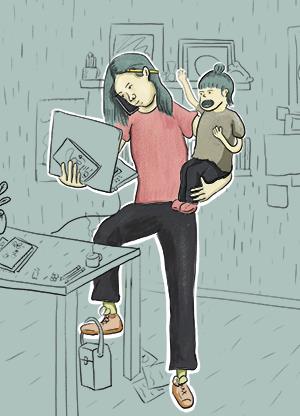The graphic design industry can seem intimidating from the outside. Many people think of long hours, strict deadlines and harsh feedback. Yet, these stereotypes don’t necessarily paint a realistic picture of the graphic design world.

The truth is that there are a myriad of benefits that come with being a graphic designer—especially for moms. You might be intrigued by this creative profession but are hesitant to invest the time and money when you aren’t sure you have what it takes to be successful.
Being a mom makes committing to a career change especially nerve-wracking. But when it comes to being a graphic designer, you may be able to use your parental experience to your advantage.
“When a mother becomes a graphic designer, the superpowers she earned as she fought the battle of parenthood come into good use,” says Holly Moore, a graphic designer at AlphaGraphics who is passionate about other moms joining the field.
We spoke with other graphic designer moms to learn about eight ways your motherly duties have prepared you for success in the field.
Moms make great graphic designers because...
1. They can read between the lines
Moms are experts at discerning the reasons behind their children’s words and behavior. Nancy Cleary of Wyatt-Mackenzie Publishing Inc. applies those same abilities when working with clients who have trouble articulating what they are looking for.
“You must listen closely to the meaning between their words and their energy, and patiently guide your client through the options, until you are both proud of the result,” she explains. You may not have realized it, but translating your baby’s cries or your toddler’s garbled sentences has actually helped you develop a marketable skill in the graphic design industry.
2. They’re extra empathetic
You feel your child’s excitement, sadness or fear as if it’s your own. Knowing how to empathize with another’s feelings can also come in handy when working with clients. Cleary says empathy is a huge asset on the job.
“Having empathy for your client can be a powerful tool. Place yourself in their position and imagine how you would want to be treated,” Cleary says. She adds that anticipating a client’s needs goes a long way in securing future business and referrals.
3. They have the ability to work from home
Rita Gonzales of Hugssy.com has been a graphic and web designer for eight years and has enjoyed working many of those years from home. She began freelance designing after her daughter was born, where she corresponded with clients via email and worked on projects while her daughter slept.
Work-from-home graphic design moms have the ability to create a schedule that maximizes time with their children. This is one of the most important benefits of the job, according to Stephanie Milanowski, graphic designer at Cardinal Letter Press. She feels she gets the best of both worlds by being able to continue the career she loves while not having to miss out on her kids’ milestones.
4. They are always adaptable
Lidia Veresco of Lidia Veresco Design admits she had to make adjustments to some of her preconceived notions about parenting when her son was born. She says her maternal instinct to be flexible and adapt to new information is critical in her graphic design business.
Veresco believes the best work comes from being willing to abandon ideas when they aren’t working. Moms do this every day. When your baby is having trouble sleeping, you try one thing after another until something works. That versatility is invaluable when working as a graphic designer.
5. They plan for mishaps
Being prepared for emergencies comes with the territory of motherhood and graphic design, according to Marie Sonder, graphic designer and web developer at EZSolution. Whether it means a quick diaper change in public or a last minute website error at midnight, moms and graphic designers know to expect the unexpected—and come prepared!
Anticipating your child’s needs has taught you some valuable lessons in foresight and preparation. Applying those skills with your clients will not only help you predict potential problems but help you keep your cool when things go awry.
6. They are creative problem solvers
Children have a unique outlook on the world around them and spending time with them can be enriching for you and your work. Moore insists her children make her a better graphic designer.
“[Children] open your eyes to beauty that is found in unusual ways. They stop to admire a dead dragonfly and the amazing pattern on its wings,” she explains. She adds that her children’s curiosity opens her eyes and mind to discover different ways to solve design problems.
7. They don’t crack under pressure
Moms get stretched in so many directions that their abilities often surprise even themselves. Moore says working late to meet harsh deadlines doesn’t faze her after surviving sleepless nights with fussy children.
“Graphic design is a wonderful career for moms. We know instinctively what our babies need, what our kids are up to and when we can shut our eyes and take a little catnap,” says Milanowski. This dexterity of focus lends itself well to meeting strict project deadlines. She believes the pressures of parenting prepared her for the pressures of the job.
8. They know their priorities
Children have a way of re-organizing everything in their mom’s life. But according to Varesco, that’s a good thing. She says her creativity was keeping her busy with too many things at once.
“Having a baby prompted me to examine my priorities. Now, I carefully pick and choose which side projects to focus on or business events to attend,” Varesco says. In graphic design, the options for potential clients and projects are endless. But with children in the picture you know exactly what your time is worth. You aren’t likely to waste your time (or your client’s) by accepting projects you aren’t invested in.
Capitalize on your qualities
Your experience as a mom has helped you acquire many of the skills needed to succeed as a graphic designer. Now that you know you've got what it takes, learn how a graphic design degree can help you develop the technical skills to complement your natural abilities.




